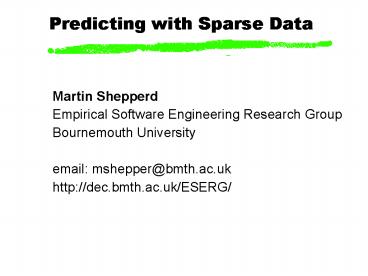Predicting with Sparse Data - PowerPoint PPT Presentation
1 / 24
Title: Predicting with Sparse Data
1
Predicting with Sparse Data
- Martin Shepperd
- Empirical Software Engineering Research Group
- Bournemouth University
- email mshepper_at_bmth.ac.uk
- http//dec.bmth.ac.uk/ESERG/
2
Agenda
- 1. Background
- 2. Data Problems
- 3. Pairwise methods
- 4. Results
- 5. Future avenues
3
1. Background
- Software developers need to predict, e.g.
- effort, duration, number of features
- defects and reliability
But ...
- noise and change
- complex interactions between variables
- poorly understood phenomena
- little systematic data
4
Effort Prediction Systems
- off the shelf e.g. COCOMO
- DIY models
- machine learning
- case based reasoning
- neural nets
- rule induction
- genetic programming
5
Problems with Off the shelf models
- Model Researcher MMRE
- Basic COCOMO Kemerer 601
- FP Kemerer 103
- SLIM Kemerer 772
- ESTIMACS Kemerer 85
- COCOMO Miyazaki Mori 166
- Intermediate COCOMO Kitchenham 255
6
A DIY Model
Predicting effort using number of files
7
Case Based Reasoning
8
Sensitivity Analysis
9
So Where Are We?
- A major research topic
- Poor results off the shelf
- Accuracy improves with calibration but still
mixed - Majority of techniques needs accurate local data
- BUT data is problematic
10
Data Problems (1)
What does a person hour of effort
mean? training sickness unpaid overtime when does
a project start and finish politics etc
11
Data Problems (2)
Shortage of data - projects can be
infrequent Heterogeneity Obsolescence Trustworthin
ess
12
3. Pairwise Methods
therefore a subjective technique is
unavoidable. Significant evidence that pairwise
judgements are more reliable than ranking /
judging groups. Only method was a proprietory
method (SSM from Lockheed). A general purpose
technique for decision making is Analytic
Hierarchy Processing (AHP) so ...
13
Analytic Hierarchy Processing
- Multi-criteria decision making technique
- From decision / management sciences
- Decision has n alternatives (elements) and m
criteria - Make pairwise comparisons
14
AHP Matrices
Each judgement reflects perceived ratio of the
relative contributions of elements i and j to the
overall component. Assume that there are n
elements, then we require n(n-1))/2 pairwise
judgements to complete the matrix. Implies
redundancy since n(n-1))/2 gtn-1 for ngt2. So aij
(wi / wj), subject to the following constraints
aij gt 0 aii1 and aij (1 / aji).
15
Example AHP Matrix
Subjective pairwise comparisons (A-B, A-C, B-C)
of ratio of contributions.
16
AHP and Effort Prediction
Our sparse data method (SDM) requires the
following steps
- Divide project into n sub components or sub tasks
(n 1). - Need a minimum of one reference component R.
- Use AHP to find contribution to overall (i.e.
project R). - Solve for all other components since R is known.
17
DataSalvage
- Developed a PC based software tool
- develop hierarchy
- make and edit pairwise comparisons
- add a reference component(s)
- calculate consistency
- generate predictions
18
http//dec.bmth.ac.uk/ESERG/DataSalvage
19
4. Some Results
BT Dataset Dataset2 Initial size 18 21 Projects
removed 4 1 Final dataset size 14 20 Min. project
(days) 97 109 Max. project (days) 573 912
20
Expert v SDM
Absolute residuals
Technique Mean Median Min Max SDM 134.8 58.5 1 56
6 Expert 139.3 70 5 571
Wilcoxon Signed Rank test rejected H0 in favour
of Ha that the SDM median error is sig. (?0.1)
smaller than the expert unaided p 0.061.
21
Robustness
22
Experience with Users (1)
Student project group effort
Project Predicted Actual prototype 23.88 n/a 1
20 TFS 76.12 382.51 318.5
23
Experience with Users (2)
- Project manager at BT
- Found pairwise comparisons easy
- Liked the technique and tool
- Found identifying criteria and weights difficult
leading to poor predictions
24
5. Future Avenues
- Great need for useful prediction systems
- Cannot always assume high quality systematic data
is available - We have shown our sparse data method to have
potential on industrial data - Unresolved issues include the choice of reference
task and attribute hierarchy

